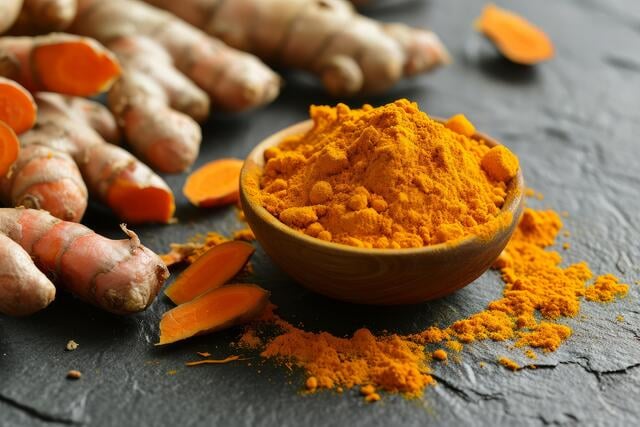
Written by Katharine Lang — Fact checked by Jennifer Chesak, MSJ
The number of people with type 2 diabetes — a condition where a person cannot regulate their blood glucose — is rising rapidly. In 2017, around 462 million people, or 6.28% of the world’s population lived with the condition.
By 2024, the World Health Organization (WHO) reported that the number of people living with diabetes worldwide had risen to more than 800 million, of whom 95% had type 2 diabetes. And the condition can lead to complications such as cardiovascular disease, vision problems and kidney disease.
Obesity and overweight are common in people with prediabetes and type 2 diabetes, and losing weight can help manage symptoms, or even reverse the condition in some. Now, a study suggests that turmeric or curcumin supplements might help people with these conditions on their weight-loss journey.
The review of 20 randomized controlled trials, published in Nutrition & Diabetes, found that turmeric or curcumin — the active component of turmeric — had a beneficial effect on some indicators of obesity, and might therefore help with weight management in people with prediabetes and type 2 diabetes.
Thomas M. Holland, MD, MS, physician-scientist and assistant professor at the RUSH Institute for Healthy Aging, RUSH University, College of Health Sciences, not involved in this study, commented to Medical News Today that:
“The findings are modest but noteworthy. The meta-analysis showed that turmeric/curcumin supplementation led to small but significant reductions in body weight, waist circumference, fat mass percentage, and hip circumference in people with type 2 diabetes and prediabetes. From a scientific standpoint, these changes, about 2 kg (5 lbs) of weight loss and [approximately] 2–3 cm (about an inch) off the waist, may seem small, but in population health even minor improvements in central obesity can reduce metabolic and cardiovascular risk.”
Turmeric has long been used to add flavor and color to foods, and can also be taken as a supplement. Studies suggest that it may have antioxidant, antimicrobial and anti-inflammatory effects, and that it is generally safe and well tolerated at the dosages found in food, although may have some side effects at higher dosages.
This latest review investigated the effects of turmeric/curcumin supplementation on measures of body size, including body weight, body mass index (BMI), percentage of fat mass, waist circumference, waist-to-hip ratio, and hip circumference, in 20 different studies.
All were randomized controlled trials comparing supplementation with placebo, carried out in adults with prediabetes or type 2 diabetes.
Participants in the studies were given dosages ranging from 80 milligrams per day (mg/day) to 2,100 mg/day, for 8– 36 weeks. The researchers noted that adverse events, such as stomachache, itching, vertigo, constipation, hot flashes, and nausea, were reported in only 3 of the 20 studies.
In people with type 2 diabetes, turmeric/curcumin supplementation led to improvements in body weight, waist circumference, body fat percentage, and hip circumference, but not BMI or waist-to-hip ratio.
For those with prediabetes, supplements significantly reduced body weight and waist circumference, but again had no effect on BMI.
The researchers also found significant associations between dosage and waist circumference, and between duration of supplementation and body weight.
Two of the study authors, Leila Azadbakht, PhD, professor of nutritional Sciences, and Mohammadreza Moradi Baniasadi, MSc in the Department of Community Nutrition at the School of Nutritional Sciences and Dietetics, both at Tehran University of Medical Sciences, Iran, commented on their findings.
They told MNT that “the most useful finding is the dose-response relationship: Supplementation for [more than] 22 weeks significantly reduced body weight —[weighted mean difference of] -2.5 kg — and doses [of more than] 15,00 mg/day lowered waist circumference — [weighted mean difference of] -1.8 cm — in [type 2 diabetes] patients.”
“This provides practical guidance for clinicians on optimal dosing and duration to achieve meaningful effects, highlighting the potential of turmeric/curcumin as an adjunct to lifestyle interventions for weight control in diabetes management,” they added.
Eamon Laird, PhD, assistant lecturer in Human Nutrition at Atlantic Technological University Sligo, and adjunct assistant professor at Trinity College Dublin, not involved in the study explained for MNT that:
“Turmeric/curcumin could influence metabolism, reducing inflammation, and potentially impacting (reducing) appetite. Some studies suggest curcumin can enhance thermogenesis (calorie burning for heat production), which could contribute to weight loss over time. Additionally, curcumin’s anti-inflammatory properties may help counteract some of the inflammation (cytokines) associated with obesity and diabetes.”
Several studies have suggested that turmeric may help with weight loss, but there is little clear evidence as to how it has its effects, as Azadbakht and Baniasadi told us.
“While the precise mechanism remains somewhat enigmatic, we believe the activation of AMPK and the anti-inflammatory properties are the most likely primary modes, as they directly link to improved insulin sensitivity, reduced chronic inflammation — common in [type 2 diabetes] and prediabetes‚ and enhanced fat metabolism,” the study authors explained.
Laird welcomed the study as interesting but highlighted “significant limitations to consider before getting too excited.”
“Firstly,” he told MNT, “out of the 20 studies in the analysis 13 are from the same country (Iran). This limits the potential effects/applicability to the general public as there could be just something unique about that population whether it be genetics or just other dietary or other components not controlled for.”
“Moreover, there was a wide range of doses and forms of the product used, wide variations in the study duration whilst the majority of the studies were in mostly older female adults,” he added.
Azadbakht and Baniasadi outlined how they hope to address these issues, noting: “We are considering further research to address limitations in the current evidence base. This includes larger, longer-term [randomized controlled trials] focusing on high-absorption formulations and combinations with lifestyle interventions.”
“We also aim to explore effects in diverse populations (e.g. varying ethnicities or comorbidities) and investigate mechanistic pathways more deeply […] to better predict responders and optimize safety.”
“This research is encouraging, but we need to be cautious. The overall effect sizes are small, and the certainty of evidence is low to moderate, meaning stronger, larger trials are still needed. […] For patients, the takeaway is that turmeric can be a helpful addition to a healthy lifestyle, but it’s not a shortcut to weight loss. Clinicians should frame it as a ‘supportive therapy’ alongside established treatments, like lifestyle and medications, for diabetes and obesity.” – Thomas M. Holland, MD, MS
Disclaimer
The information contained in South Florida Reporter is for general information purposes only.
The South Florida Reporter assumes no responsibility for errors or omissions in the contents of the Service.
In no event shall the South Florida Reporter be liable for any special, direct, indirect, consequential, or incidental damages or any damages whatsoever, whether in an action of contract, negligence or other tort, arising out of or in connection with the use of the Service or the contents of the Service. The Company reserves the right to make additions, deletions, or modifications to the contents of the Service at any time without prior notice.
The Company does not warrant that the Service is free of viruses or other harmful components
This article originally appeared here and was republished with permission.












